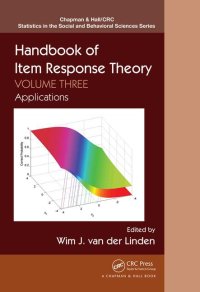
Ebook: Handbook of item response theory, volume three: applications
Author: Wim J. van der Linden (editor)
- Tags: Psychological Methods & Statistics., Psychometrics/ Testing & Measurement Theory., Testing Measurement and Assessment., STATSnetBASE., SCI-TECHnetBASE., STMnetBASE., Item response theory., Psychometrics., Psychology -- Mathematical models., PSYCHOLOGY / Reference.
- Series: Chapman & Hall/CRC Statistics in the social and behavioral sciences
- Year: 2018
- Publisher: CRC Press
- Edition: 1
- Language: English
- pdf
Drawing on the work of internationally acclaimed experts in the field, Handbook of Item Response Theory, Volume 3: Applications presents applications of item response theory to practical testing problems. While item response theory may be known primarily for its advances in theoretical modeling of responses to test items, equal progress has been made in its providing innovative solutions to daily testing problems. This third volume in a three-volume set highlights the major applications.
Specifically, this volume covers applications to test item calibration, item analysis, model fit checking, test-score interpretation, optimal test design, adaptive testing, standard setting, and forensic analyses of response data. It describes advances in testing in areas such as large-scale educational assessment, psychological testing, health measurement, and measurement of change. In addition, it extensively reviews computer programs available to run any of the models and applications in Volume One and Three.
• Includes contributions from internationally acclaimed experts with a history of original and successful work in their respective areas
• Provides extensive cross-referencing and common notation across all chapters
• Shows how to apply IRT in educational and psychological measurement as well as medical diagnosis and marketing research
• Discusses the computer software programs available for running any of the models and applications
"Drawing on the work of internationally acclaimed experts in the field, Handbook of Item Response Theory, Volume 3: Applications presents applications of item response theory to practical testing problems. While item response theory may be known primarily for its advances in theoretical modeling of responses to test items, equal progress has been made in its providing innovative solutions to daily testing problems. �Read more...
"Drawing on the work of internationally acclaimed experts in the field, Handbook of Item Response Theory, Volume 3: Applications presents applications of item response theory to practical testing problems. While item response theory may be known primarily for its advances in theoretical modeling of responses to test items, equal progress has been made in its providing innovative solutions to daily testing problems. �Read more...
Abstract: "Drawing on the work of internationally acclaimed experts in the field, Handbook of Item Response Theory, Volume 3: Applications presents applications of item response theory to practical testing problems. While item response theory may be known primarily for its advances in theoretical modeling of responses to test items, equal progress has been made in its providing innovative solutions to daily testing problems. This third volume in a three-volume set highlights the major applications.Specifically, this volume covers applications to test item calibration, item analysis, model fit checking, test-score interpretation, optimal test design, adaptive testing, standard setting, and forensic analyses of response data. It describes advances in testing in areas such as large-scale educational assessment, psychological testing, health measurement, and measurement of change. In addition, it extensively reviews computer programs available to run any of the models and applications in Volume One and Three. FeaturesIncludes contributions from internationally acclaimed experts with a history of advancing applications of item response theoryProvides extensive cross-referencing and common notation across all chapters in this three-volume set Underscores the importance of treating each application in a statistically rigorous wayReviews major computer programs for item response theory analyses and applications. Wim J. van der Linden is a distinguished scientist and director of research and innovation at Pacific Metrics Corporation. Dr. van der Linden is also a professor emeritus of measurement and data analysis at the University of Twente. His research interests include test theory, adaptive testing, optimal test assembly, parameter linking, test equating, and response-time modeling as well as decision theory and its applications to problems of educational decision making. "--Provided by publisher